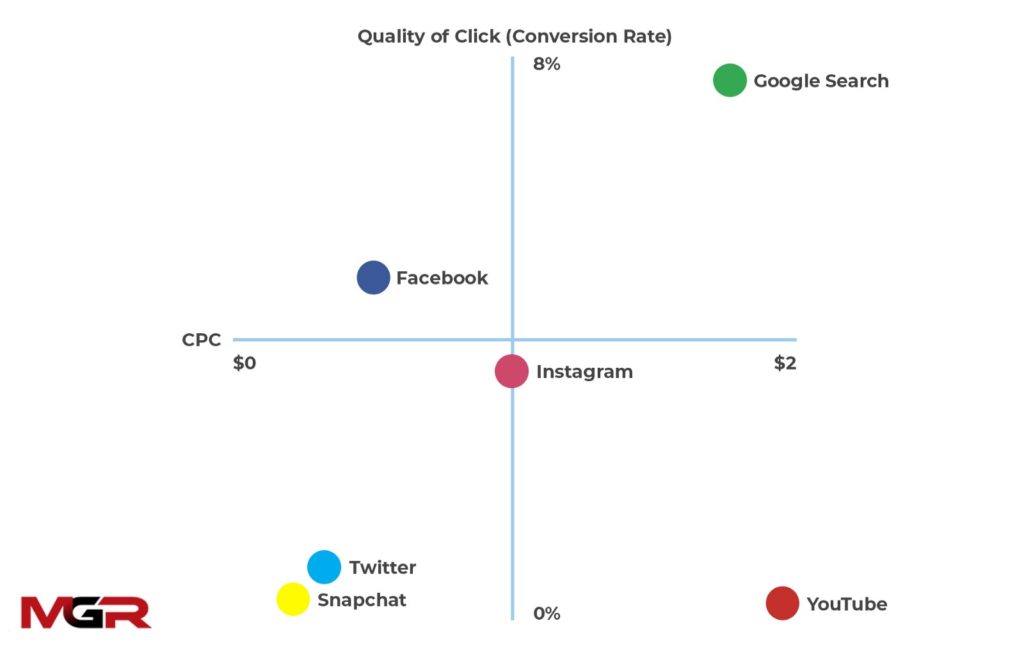Quality and quantity are the only two metrics that matter in life and the same goes for marketing.
This chart that compares a marketing platform’s quality of clicks (Conversion Rate) to the quantity of clicks your money can buy (Cost per Click). If you’re one of these platforms, the best place to be is in the upper-left quadrant, and conversely the bottom right is where you absolutely don’t want to be. The further ‘up and to the left’ you are on this chart, the better bang-for-your-buck you can offer as an ad platform.

Let’s take a look at each ad platform individually and see what we can learn about them based on where they land on this chart.
Facebook is the only platform that has found itself in the coveted upper-left quadrant. While it doesn’t offer quite as a high conversion rates on average as Google Search ads do, Facebook has two distinct advantages: their ads are much cheaper and when you advertise with them you get to show off more than just a line of blue text. The average CPC of a Facebook ad is still less than half that of Google Search ads, and with Facebook ads you have the massive added bonus of visuals. On Facebook you can stand out from the crowd with unique ad creative, something that’s not possible on a Google Search page.
Facebook is the darling of digital marketing for a reason, and their placement on marketing’s most important chart only goes to further show why.
Google Search
The 20 year-old conversion machine keeps on chuggin’. Over its near 20 year existence Google’s search engine ads have dominated the marketing landscape, and for good reason. They convert higher than any other platform and still do.
The only reason Google Search ads aren’t more powerful is simply due to their price. In Google Search ads you bid for keywords in an auction, and in auctions demand drives the price up. When you have such high conversion rates it tends to draw quite a bit of demand. Nevertheless Google Search ads are still incredibly effective, they just take a little more work and expertise to nail down the right keyword strategy.
Instagram is incredibly similar to Facebook (obviously), but the ads are slightly more expensive at the moment. The quality of the clicks is very high because you can take advantage of Facebook’s hyper-targeting capabilities combined with incredible branding opportunities due to Instagram’s visual nature. It’s possible Instagram could overtake its parent, Facebook, soon but that day has not yet come. But, if you’re not running Instagram ads yet you are sorely missing out.
YouTube
This one’s interesting. YouTube can be an incredibly effective tool if used in the right context, but clearly finding that right context has proven difficult for many marketers. YouTube’s conversion rates on average are very low, but the price you’re paying for their ads is incredibly high. We have seen in our own experience remarkably GOOD performance on YouTube, but that’s because we place an extreme focus on context. For example, product or service demonstrations often do well, especially when targeted to people watching videos related to the problem that product or service solves.
Where YouTube ads fail is in the use of broad targeting and generic ad creative. YouTube ads let you show the audience something, but many advertisers are not using YouTube to do so, which is why it’s landed in such a poor position on the chart. YouTube ads can definitely work, but you have to know what you’re doing, and clearly most businesses who are advertising on YouTube don’t.
Snapchat & Twitter
We’re combining these last two because of their nearly identical positioning on the chart. Their ads are cheap, but it’s because they don’t convert that well so demand has remained low. Snapchat has a limited audience, unless you’re going after the 15–35 market and are selling consumer goods, Snapchat won’t work well for you. Because of this, Snapchat has alienated any businesses who want to target people outside of that demographic, until they can broaden their userbase their positioning on this chart will remain the same.
As for Twitter, they do have a broader userbase, but don’t have the same level of targeting and quality ad placement that their biggest competitor Facebook does. We wrote an entire article dedicated to how Twitter can improve its ad platform, but thus far they haven’t listened. Due to their ad product being so similar to Facebook’s but performing significantly worse, businesses and marketers such as ourselves are going to opt to point our budgets Facebook’s way until Twitter can prove they drive a meaningful ROI.
Final Note
Remember this chart represents the AVERAGE CPC and Conversion Rates across all industries. You can still run a very successful YouTube or Snapchat campaign and run a poor performing Facebook or Google search campaign, but this chart gives a good idea of what to expect when you advertise on each platform.
Thank you for reading. Until next time, this is Manuel Gil del Real (MGR)




